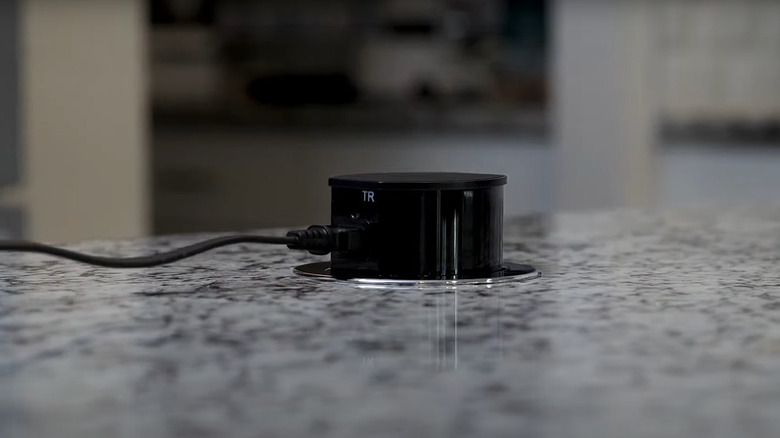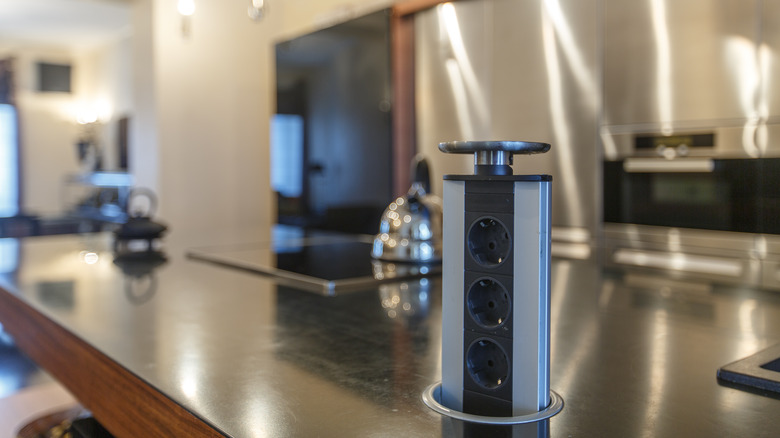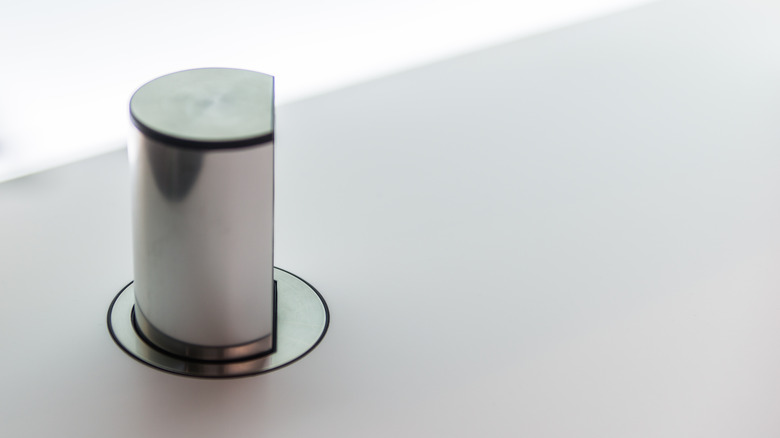The Seamless Electrical Outlet Upgrade You'll Wish You Added To Your Kitchen Sooner
There was a time when a family could be proud of their electrical kitchen gadgets. As predicted in a 1920 issue of "Edison Monthly," the future would be one of, in their words, "Very strange and rapid processes, [by which] food is prepared, cooked, served, whisked away and all traces of it removed."
Well, we never quite managed that level of automation, or even to hide the making of sausage in our kitchens. However, we have begun in earnest to hide all traces of the electricity itself. Enter the seamless pop-up countertop receptacle, which promises to practically make your counter-height outlets disappear, removing unsightly wall outlets from your backsplash and leaving unaware houseguests oblivious on how to make coffee or toast in the morning.
Homeowners tend to have strong feelings about kitchen outlets, and most people love these pop-up versions that can be called upon by a simple press to rise from your countertops, ready to fire 110 volts (give or take) into whatever appliances you usually keep hidden in your kitchen. The National Electrical Code essentially requires that a kitchen island include pop-up receptacles, or that you at least run the wiring for them. If your island is more than nine square feet, you'll need at least two outlets, so the price tag of some pop-ups can be intimidating.
We've seen them for as much as $549 each. But you can choose pop-ups that have all the functionality — minus the seamless look — for far less.
When it comes to types and features of pop-up receptacles, the sky's the limit
Pop-up countertop receptacles are available in a shocking array of prices, features, and designs. There are 15-amp and 20-amp models (since you won't likely find any 20-amp kitchen counter appliances, the 20A models probably exist for 20-amp kitchen electrical circuits on which there is only a single receptacle, in which case the receptacle must also be 20-amp). There are pop-up, pull-up, and flip-up models, all available in a variety of finishes and colors. Some have tamper-resistant outlets. Among the pop-up versions, some have a circular column that rises from the countertop, while others have rectangular columns, and some of the models with circular columns rotate to make accessing the receptacles easier. A handful have wireless charging circuits, and some include built-in Bluetooth speakers. Pop-up models can be single- or double-sided, while flip-up models occasionally have more than one receptacle strip that flips up.
Some features relate directly to NEC code requirements for kitchen counters and islands. Some models are UL listed, which is a requirement for use in an island for new construction. They come in both direct-wired and corded versions, and new construction usually requires that you use a direct-wired model. GFCI protection is required for kitchen receptacles and some pop-ups come with GFCI, but you can also get it from an upstream receptacle or from the circuit's breaker. Most manufacturers supply tamper-resistant outlets, which is also an NEC requirement for kitchens.
The installation challenges of a pop-up countertop receptacle
Pop-up receptacles can be surface-mount or flush-mount, with most people's favorite being the almost-seamless flush-mount types that can take a disc of your countertop material as a covering. With all those features and prices ranging from $27.99 to $550 or more, the installation process varies quite a lot.
That said, the installation process for Point Pods is a good illustration of how the seamless pop-ups work. The most important part is the first step, which involves cutting a four-inch hole in the countertop with a hole saw, waterjet, or CNC machine. As you might have guessed, manufacturers usually recommend that you use a stonemason or your countertop supplier to make these cuts. Cutting a perfectly plumb disc out of your countertop with a hole saw might be challenging, and trying to make a rectangular cutout yourself might prove impossible without experience.
After that, installation involves gluing a filler ring in the hole with silicone adhesive. Glue the mounting flange to the underside of your countertop, and drop the outlet into place. The part that holds your disc of countertop material has depth adjustment screws to accommodate just about any material thickness. Plug it in and you're ready to pop. Point Pod units are raised and lowered via a built-in motor, and they're equipped with plug-in electric cords rather than cable or terminals for hard wiring. This makes them perfect for a retrofit or renovation ... and it's a common enough feature that you don't necessarily have to sticker-shock yourself with the $549 receptacles.


